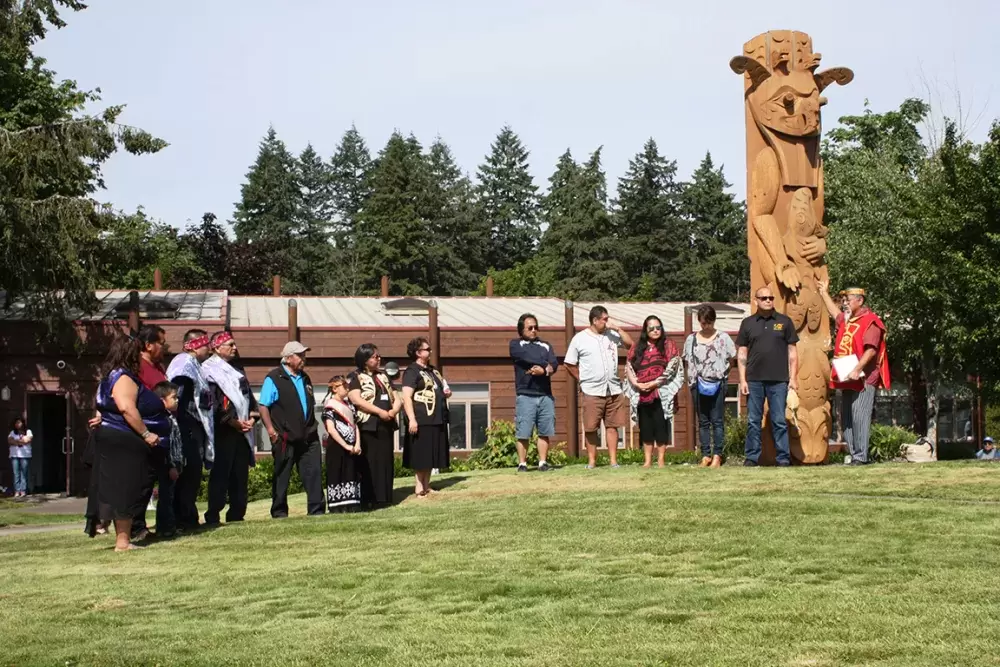A significant totem pole given to Cowichan Tribes decades ago has been restored in an effort to preserve its beauty and extend its longevity. Carved by late Arthur Thompson of Ditidaht, a renowned artist who was instrumental in the fight for justice for residential school survivors, the pole has special significance because Thompson has roots in Cowichan.
The totem pole, which stands in front of the Cowichan Tribes Administration building, was carved in 1996 by Thompson, who was proud of his Cowichan heritage. Thompson’s mother Ida came from the Modeste family of Cowichan Tribes.
According to Cowichan elder Violet George, the pole was starting to show its age and Cowichan member Doug August was contracted to restore the pole.
On May 31, Cowichan Tribes spent the day celebrating the 50th anniversary of their tribal administration. According to Cowichan Tribes, their first administration office was a small A-frame building opened in 1966 with two employees and a band manager.
Today, there are far more offices with a large staff serving about 4,600 Cowichan members.
The 2015 Cowichan Princess, Shiloh Louie, age 9, took the microphone and welcomed the people to the 50th anniversary celebration. She said Cowichan Tribes Chief & Council support Cowichan culture, which, she said, is the backbone of their community.
“It is important to keep it (culture) alive so we can pass it on to the next generation,” said Louie.
Invited guests were seated in front of the totem pole on the morning of the celebration. The refurbished pole had already been raised but had blankets covering the sacred SXweXwe mask at the top of the pole.
Dozens of guests were thanked, according to Cowichan tradition, for bearing witness to the unveiling of the totem pole.
Elected Chief William Seymour, his council and other Cowichan members shook hands with special guests, thanking them for showing up for this special day.
The hosts asked that all recording devices be put away as they called upon sacred mask dancers to bless the pole as female singers drummed.
Nuu-chah-nulth people were there to celebrate the restoration of the pole. Speaker Ron Hamilton pointed out that usually, once a pole is in place, it is left to Mother Nature, who will eventually reclaim the pole after it rots and falls back to the earth.
He thanked the leaders of Cowichan Tribes for preserving the pole. “It was important to my late cousin (Arthur Thompson) to leave something where his late mom came from; he was proud to be half Cowichan,” said Hamilton.
Derek Thompson stood by the pole in place of his father, Boquilla (Charlie Thompson), who was Arthur Thompson’s brother.
“My late Uncle Art was the youngest brother in the family and he was a residential school survivor,” said Derek Thompson.
He went on to tell how Art was at the forefront of the move to give residential school survivors a voice. He was determined not to be silent.
“He had a presence, a voice and he told us to never forget who we are,” said Thompson, adding that his late uncle Art always talked about the importance of self-determination.
And so, as it was important for Art Thompson, it is also important for his loved ones that his work is kept alive.
“It is an honor and privilege to be here on behalf of my family; I am proud of my uncle and his continuing legacy,” said Derek Thompson.
The pole was blessed again according to Nuu-chah-nulth tradition. Hamilton thanked the hosts and praised their young princess, Shiloh Louie, saying she was raised well as shown by her strong public speaking skills.
He went on to explain the different elements of the pole, saying his late cousin topped his pole with a sacred Cowichan mask that reflected the maternal side of Thompson’s family.
According to Boquilla, the figure is called a SXweXwe, and some Salish families have rights to use the SXweXwe mask ceremony. He likened its level of sacredness to that of the Hiinkiits’im.
The Modeste Family has rights to the SXweXwe and so it is prominently displayed on the pole holding a salmon, which is plentiful in the Cowichan River.
Hamilton said Art Thompson knew the importance of the winter dances for the Cowichan people. The winter dances end when the frogs start singing and this is why he carved a frog at the bottom of the pole.
Hamilton thanked the people of Cowichan again, saying they have so much to be proud of. He asked them to allow the pole to stand as a mark of their successes.







